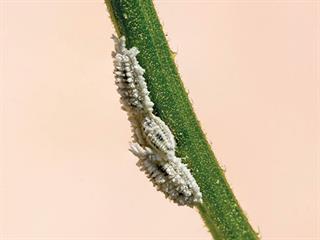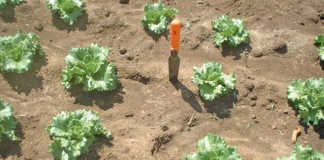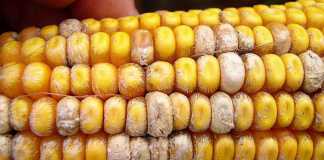
Male mealybugs are 3mm to 4mm in length with a single pair of wings. They lack mouthparts and are short-lived, spending their time flying around searching for females. The latter are 4mm to 5mm long, with soft, segmented bodies covered in waxy secretions. Lacking wings, they cluster on the plant. The commercial crops at risk include: apples, cassava, celery, citrus plants, coffee, eggplant, grapevines, grapes, groundnut, maize, millet, pears, potatoes, quinces, sorghum, sugarcane, sweet potato and tobacco.
Severe damage
Mealybugs suck sap from young leaves, growth points, fruit and the root system. A plant is susceptible to attack during the growing phase, flowering stage, and fruiting stage. A severe outbreak can lead to yellowing of the leaves, which eventually fall off, as do the inflorescences and young fruit. Fruit yield may be greatly reduced.
A by-product of sap sucking is honeydew. This sticks to the plant and encourages the growth of sooty mould, which can inhibit photosynthesis. As with aphids, the honeydew is harvested by ants that protect the mealybugs from predators.
A heavy infestation of mealybugs manifests as a white waxy mass on the stems, fruits and underside of the leaves, usually along the veins. These infestations can suck so much sap from a plant that it will begin to wilt. Mealybugs that feed on fruit can severely reduce its market value. The fruit discolours and develops ‘lumps’.
Reproduction
Some species of mealybug produce live young, while others lay eggs – up to 500 at a time. Nymphs (an in-between stage in the life-cycle) hatch from the eggs. They are highly mobile often travelling considerable distances.
Control measures
Neem oil, neem kernel water extract, insecticidal soap, vegetable oils and mineral oils have all been shown to be effective methods of controlling infestations. Natural predators include ladybird beetles and their larvae, lacewing larvae, hoverfly larvae and several species of parasitic wasps. However, the effectiveness of natural predators will be limited if ants are present, as they will protect the mealybug.
Controlling ants may thus help to control mealybugs. In small-scale operations, mealybugs can be removed by hand, and infected plants can be pruned or destroyed. Plants can be sprayed with a high-pressure stream of water – insecticide sprayers will produce enough pressure. Mealybugs knocked to the floor will fall victim to ground predators.
Check the crops regularly. If the bugs are tended by ants, the latter may return them to the plant.
Please note: this series is intended primarily as a guide to identifying pests. The control methods discussed are merely suggestions. For help with area- or crop-specific measures, please consult your agricultural extension officer.
Paul Donovan advises farmers on controlling crop pests.













